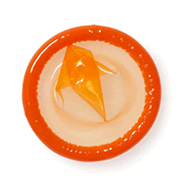Condom: Basic Info

External condoms, which are usually just called condoms, are one type of barrier method of birth control, which means that they prevent pregnancy by physically blocking sperm from getting to eggs. Condoms fit snugly over the penis so that when ejaculation happens, the semen (the whitish fluid that contains sperm) stays inside the condom and out of the vagina, which keeps sperm away from any eggs. Each condom can only be used one time.
Condoms are one of the most popular forms of birth control out there, and there are lots of types made of different materials, in different sizes, with lube and without, and in different colors, flavors, and textures. There are also internal condoms, which are placed inside the vagina instead of being placed over the penis.
Condoms and internal condoms are the only kinds of birth control that help prevent sexually transmitted infections (STIs) as well as preventing pregnancy. But not all condoms are effective against STIs. Natural membrane condoms, sometimes called lambskin or natural skin condoms, are the one type of condom that does not prevent STIs. Natural membrane condoms are not as commonly used, but they are one of the condom options that are safe for people with latex allergies.
Quick Facts
Very effective if you use them correctly, but not super effective the way most people use them. Hormone free, protect against STIs, and don’t require a prescription, but they do require work.
- Effectiveness
Condoms are pretty effective the way most people use them.
Perfect Use: 98% effective.
Typical Use: 87% effective.
- Hormones
Condoms are hormone-free.
- Side effects
If you’re sensitive, they could cause a little irritation. They may reduce sensation slightly when you’re having sex.
- Cost
Available for free at many clinics. Otherwise, around $1 each, but the price varies.
- STI protection
Condoms offer STI protection as well as pregnancy prevention.
- Ongoing effort
You have to make sure to use condoms correctly every time in order for them to be effective at preventing pregnancy and STIs.


